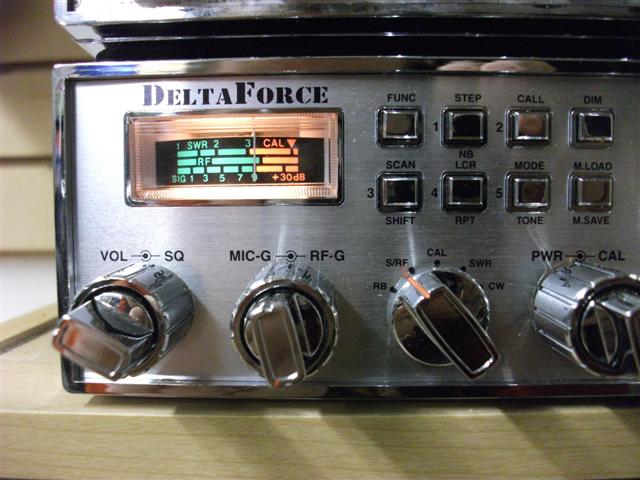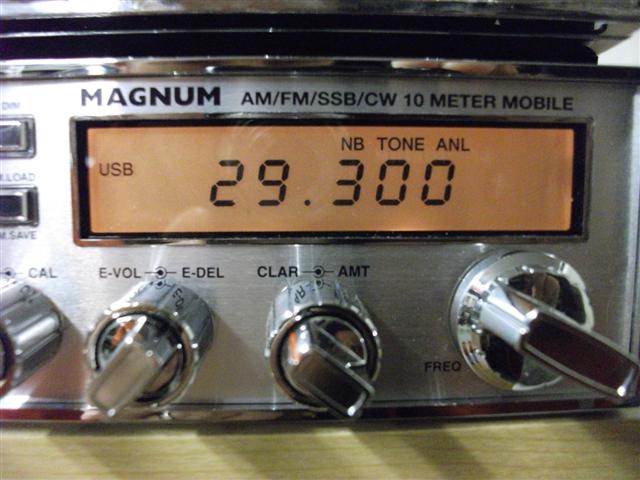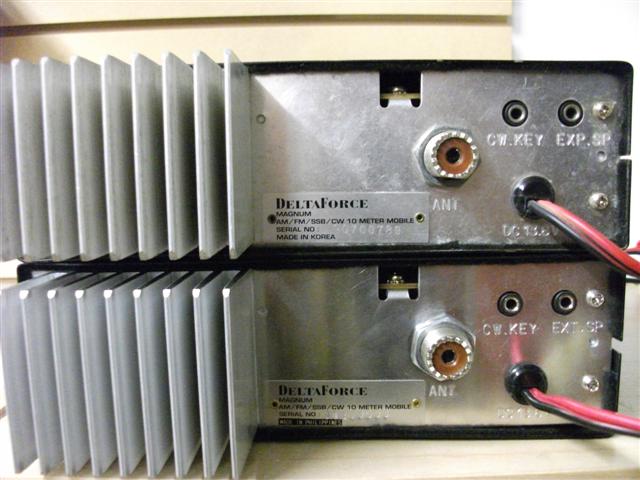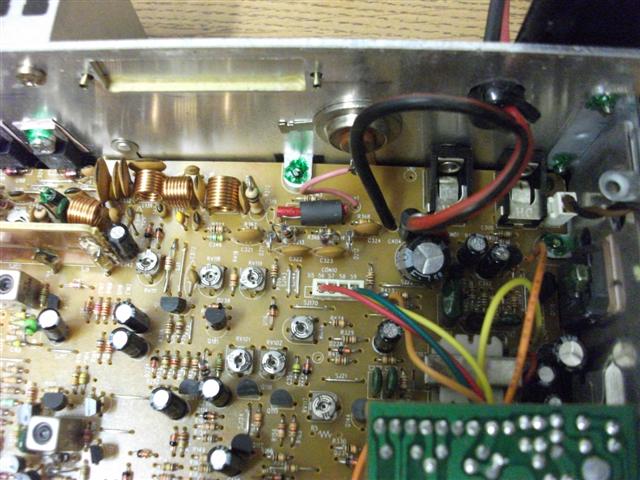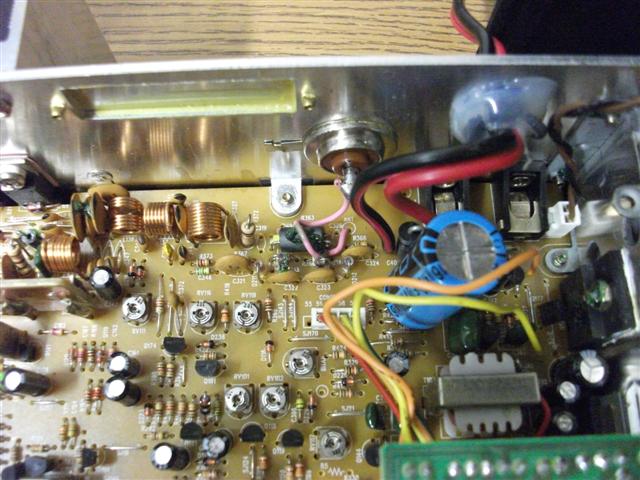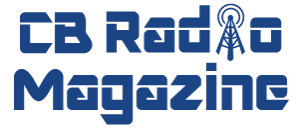Magnum DeltaForce 10 Meter Export CB Radio Review
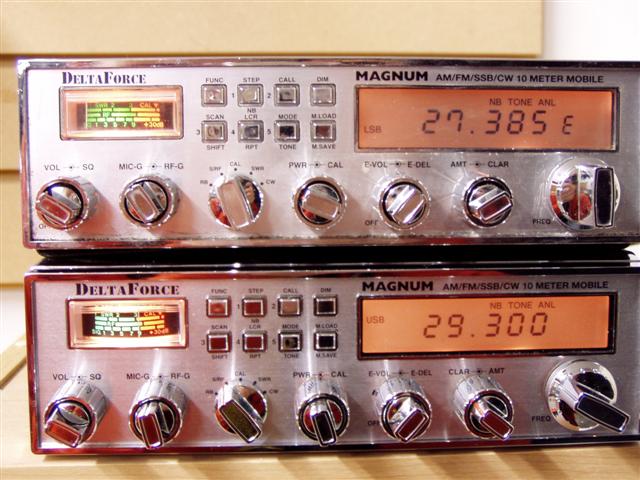
If youre into CB and Export radios than youre probably familiar with Magnum Radios (RF Limited), a very popular export radio manufacturer headquartered in Washington State. Youve probably seen their newer radios such as the Magnum S-3, S-6, S-9 and OmegaForce, but you may not be familiar with the Magnum DeltaForce, which could be considered the radio that really brought Magnum into export popularity.
The DeltaForce was a culmination of radio ideas in the hobby. Operators loved their HR2510’s and old 2950’s but many were asking for features such as the dual echo and variable talkback. Magnum created a radio that had nice audio on AM and SSB, good output potential, and very good SSB frequency stability. The DeltaForce was able to cross some lines and give people a radio that could be loud on AM and provide clean, more technical operation on SSB. This popular blend of features later led to the development of the next generation, the Magnum Omegaforce.
The Magnum DeltaForce is a 10 meter export radio with AM, FM, CW and LSB/USB capabilities. It is modifiable for extended frequency coverage (including CB band) and has an LCD display with 5 digit frequency display. When we discuss features, this radio really is the full package.
- Volume
- Squelch
- Mic Gain
- RF Gain
- Variable Power
- Dual Control Echo
- Variable Talkback
- Clarifier
- Rotary Channel Changing Knob & Up/Down buttons on microphone
- Roger Beep
- Rotary Switch for RB, S/RF, CAL, SWR, CW
- Calibration Knob
- Noise Blanker
- Last Channel Recall Button
- Hi/Low Tone Button
- Scan Button
- Dimming Button
- Step Button
- Mode Control Button
- Memory Button Control (for memory buttons)
- LCD 5 Digit Display
- Physical S/RF/SWR Meter
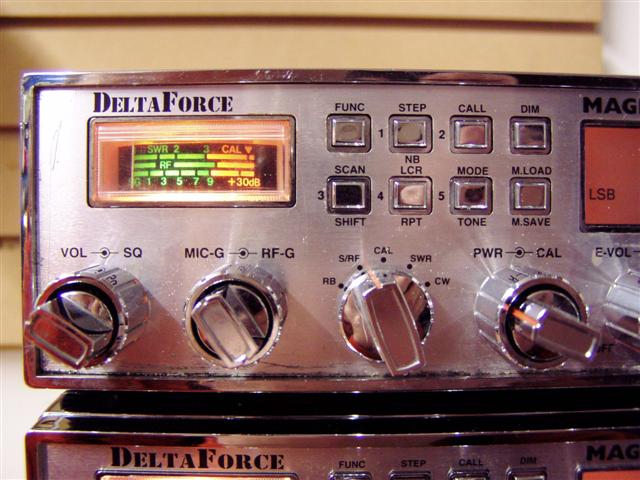
Lets discuss a couple of the key features that make the DeltaForce such a neat radio.
- Mode, Call, and Memory Channel buttons
While most export radios require you to flip band switches A through F or use hi/lo buttons to access all the frequencies, the DeltaForce has a microprocessor which allows you to flip through the bands with the push of the call button. Instead of having to flip an AM, FM, USB, LSB, CW switch back and forth it has a mode button which provides this function.
The memory channel button feature is perhaps my favorite feature of all. This radio has 5 dual use buttons which can be used to store your favorite frequencies (something also found on the Magnum 257 and Omegaforce). Not only can you store the frequency but it also stores the mode (AM,FM,LSB,USB,CW) that you want to use on that frequency. Ive talked in other reviews about how much I enjoy using radios with this ability. You can jump from 27.455 LSB to 27.185 AM or 28.4000 USB with just the push of a couple of buttons and with practice it only takes seconds. On radios like the SS-158EDX the same change would require you to change the band knob, the mode knob and then use the channel selector to move through the channels.
- Variable Power
This feature is becoming common on just about every export radio on the market, but there was a time when many radios did not have this ability. The variable power on the DeltaForce allows you to set the radio to a low deadkey for running an amplifier or a high setting for running barefoot.
- Dual Echo Controls and Variable Talkback
These two features really go together. While many purists see echo ability as an annoying toy, a large proportion of operators like to have it on a radio as an option. If used mildly it can add a distinct tone and uniqueness to your transmission without making you sound like a total loser. Of course it can be fun from time to time to sound like youre standing in a large tunnel, but for most people its frowned upon. The dual echo controls on the DeltaForce allow you to control the amount of echo and the delay of the echo. This means you can add just a slight touch of echo to make it sound like youre in a big room, or you can have a repeating echo that will repeat numerous times before fading out.
When you have echo as a feature on a radio, you need to have talkback so you can adjust the echo. The variable talkback on the DeltaForce allows you to hear yourself very well. Often a big problem with talkback in radios that have been tuned up for loud modulation is feedback. Having the ability to variably adjust your talkback means you can set the talkback to the optimum level and if you encounter any feedback you can turn it down slightly.

- Scanning
Few CB or export radios on the market have the ability to scan. Scanning allows you to set the squelch to a certain level and then tell the radio to scan through the frequencies until it finds a signal that is strong enough to break the squelch. This is a very sought-after feature and many times Ill get emails from potential buyers asking which CBs can scan? If youre in an area where not many people talk and you like to be able to find other stations this feature is very useful. Or if youre a driver and as you go down the road you want to listen for other drivers talking or giving info the scanning feature will allow you to go through all of the channels and hear who is on. It definitely beats spinning the dial through all 40 channels every 5 minutes to see who is talking.
PERFORMANCE
While lots of features are fun they dont matter one bit if the radio itself cant perform. Its another point that makes this radio such a complete package. The DeltaForce is a great all around performing radio.
- Receive
While this radio might appeal to large audience of CBers a majority of the owners of these radios are hobbyists who talk daily or like to shoot skip. For that group of operators having a radio that can pick up far-off DX stations is important and the DeltaForce delivers. I found that the DeltaForce picked out far-off stations easily for DX and for local talking allowed me to hear everyone thats within my range. With some of the microprocessor-controlled radios you will tend to get more high-end hiss in the receive. I did notice a bit of this when I first was testing this radio, but with some tuning I was able to quiet down the receiver substantially.
While this radio does have a LCD display many of the more traditional CBers will appreciate the mechanical S meter. Very few radios incorporate both of these features on one radio and I know that a lot of people dont like the bar graph type meters as they dont offer enough incremental readings so the S meter is a big plus for this model. While the noise blanking in these radios is effective I will say that much like the Magnum 257 I dont think its on par with some of the other models in the lineup (compared to a Magnum S9 we tested). In a mobile install the Magnum 257 and DeltaForce both do suffer from electrical interference but since they pull in far-off signals so well its something easily ignored.
- Modulation
I wouldnt characterize these radios as being loud in the same sense as some of the later Magnum models like the Omegaforce or S9. As a stock radio you can adjust the modulation inside to maximum and have very good modulation and clear audio. On SSB your voice will come across as loud and crisp, but if youre a big AM talker you might find the audio not quite at the same level as a Galaxy or Connex or the more recent model Magnums (Magnum included the Top Gun Modulator on the Omegaforce and S9, giving them very loud and punchy AM Audio). Have no fear though the DeltaForce has more modifications available than Tiger Woods has mistresses. Youll find multiple sites on the web with information for multiple types of modifications that can be done to this radio. One of the most popular is an NPC mod which can give this radio loud modulation or you could opt to install the Top Gun components that are now included on the newer Magnums. Additionally the stock microphone sold with this radio actually was a power microphone with gain (much like the microphone that was sold with the Magnum 257).
- Output
These are dual final radios and as such you most likely will see 25-30 watts with a mild tune on AM and SSB. With a little more aggressive tuning and some modifications these radios can do 35-40 watts peak. The DeltaForce will drive amplifiers very well and even during testing when pushing the radio to high output numbers on SSB we didnt encounter distorted signals. The radio can get a bit warm with heavy use, but a heatsink at the rear of the radio does well to dissipate it and keep the radio at a reasonable operating temperature.
- SSB Stability
Maybe the most important selling point for any SSB export radio is the ability of the radio to stay on frequency without constantly fiddling with the knobs. Few export models can boast that they have little to no drift. The HR2510/2600/Lincoln were popular because of this and the 2950DX is also a favorite because of minimal drift. The DeltaForce (and the newer Magnum 257 & OmegaForce) all use a microprocessor controlled TX and RX circuit which gives these radios excellent stability on sideband. The 2950DX does use this type of technology as well and that’s why it’s also known for its stability. Compared to other SSB export models (Connex, Galaxy, Superstar) that are known for having some drift issues the DeltaForce is definitely a step above.
TALKING POINTS
While this radio has plenty of features and great performance there are a couple of points that I thought should be brought up –
- Direct Sunlight on the LCD
If you live in California, Hawaii or Florida and have Baywatch type weather everyday youll need to know that in really sunny weather and direct sunlight the display can be a bit hard to read. While its still better than the RCI-2950DX display it can be tough at times.
- Frequency display isnt a frequency counter
While the LCD readout can be set up to show either a channel readout or frequency readout, the frequency display doesnt show your actual receive and transmit as you control or change it with the clarifier. Now while this might be a negative to some people, this radio has very little to no drift so staying on frequency isnt an issue. If youre someone who likes to see when you change your clarifier from 27.3850 to 27.3851 then you may not like this type of display. On the plus side though you can use the step button to control the frequency. So if you want to go from 27.3850 to 27.3800 you can do so using the step button. The clarifier on this radio is not unlocked from the factory so if you want to go in-between channels you do so by using the step button which is an easy way to navigate.
- Knob/Control Feel
Its been a complaint on many of the radios in the Magnum line that the knobs feel cheap compared to some other brands. Some people complain that they have too much play or feel loose and while I often agree that they dont have the best feel to them, Ive never run into any major problems with them breaking or failing. So while its an aesthetics issue it isnt a functionality issue. The dual knobs on this radio all work very well.
10 METER USE
**Please note the use of this radio on Amateur radio frequencies is limited to operators who have a valid Amateur radio license. If you do not have a ham radio license DO NOT operate this radio on ham radio frequencies. The CB band is from 26.965 to 27.405, if you intend to use the DeltaForce as a CB radio (illegal according to FCC rules) do not operate outside of those frequencies as you may be interfering with vital emergency or military communications.
While some ham radio operators will cringe at the thought of anyone using an export radio on the ham bands, certain models can perform quite well if set up properly. The RCI-2950DX, HR2510, 2600, Lincoln, and Magnum 257 have all been used on ham frequencies with positive results. While there continues to be a huge amount of backlash from the ham radio community regarding export radios, the truth is that in many cases you would not be able to distinguish these radios on the air from an actual certified 10 meter radio such as the HTX-100 or HTX-10. While the addition of echo and talkback reminds us that the target audience for these radios may not be the U.S. amateur community I dont want to discredit their actual ability to be used as 10 meter radios. The key to running a DeltaForce on ham frequencies is to run the radio at moderate levels of modulation and to follow all rules and regulations appropriately. There are 1,000s of licensed ham radio operators using these types of export radios on 10 meters daily without any issue; in fact, Ive heard a station operating a stock DeltaForce on 10 meters and they sounded very good.
CONVERSION
There were changes in these radios from the early production models to the later ones. The conversion process to open up extended frequencies on these radios varied from model to model. On early models it required removing a resistor and adding another resistor, on some later models you only had to remove the resistor, and on the last versions you had to move a small jumper
We have two productions models on our bench currently – the older model was made in Korea and you can usually tell the older models by the separate talkback and echo boards, the later models used one long board.
Older version with two boards on right bridged together
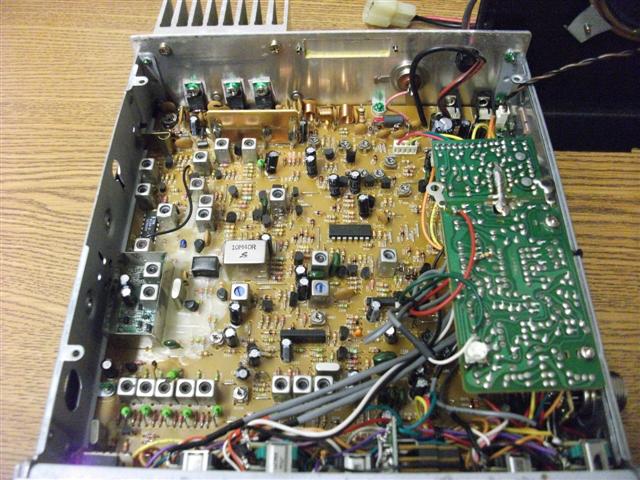
Newer version using one full board

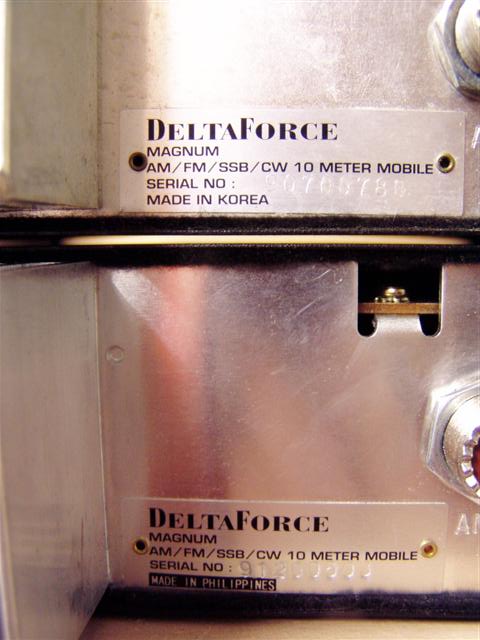
The resistor in question that has to be removed is D555 and to access it you can remove the frequency control knob – the full instructions can be found HERE
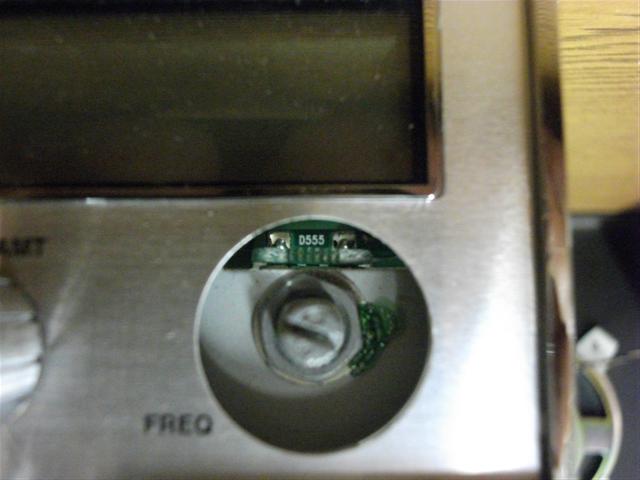
Looking at the green circuit board in the picture below, if you look just to the right of the yellow wire you can see where a small resistor has been added to this older version for the frequency conversion.
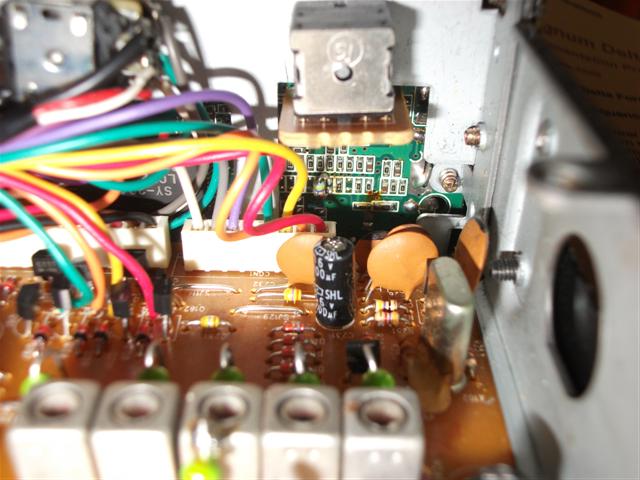
SUMMARY
While the DeltaForce has been aptly replaced by the newer OmegaForce, it still is a very popular model and the ones being sold on eBay still fetch a pretty penny. When this radio first came out 10 years ago it was a groundbreaking product from Magnum. Its ability to perform on AM and SSB while providing excellent audio, frequency stability, and incorporating features like echo, talkback, variable power, and memory channels was something that encouraged the hobby and the industry to move forward into a new era of export radios.
DeltaForce radios are getting harder to find, although I do see one or two come available every week on eBay but the bidding is pretty competitive. Because of the large number of modifications available for these radios its best to look for one that has had less done to it, only because it means you can make sure that any mods that are performed can be done properly. Ive seen quite a few of these radios with modulation limiters removed (not recommended or needed on the DeltaForce) and other pieces hacked up.
When running the two DeltaForces I own for this review its hard to believe that they are getting on in years. Although one of the radios that I had mobile has some good wear on the case, the faceplate has held up extremely well. The new OmegaForce S-45 model takes the best of the DeltaForce and adds even more, but if you ever see a good deal on a used DeltaForce on craigslist or at a garage sale, its one model I wouldnt pass up owning.
ADDITIONAL PICTURES
